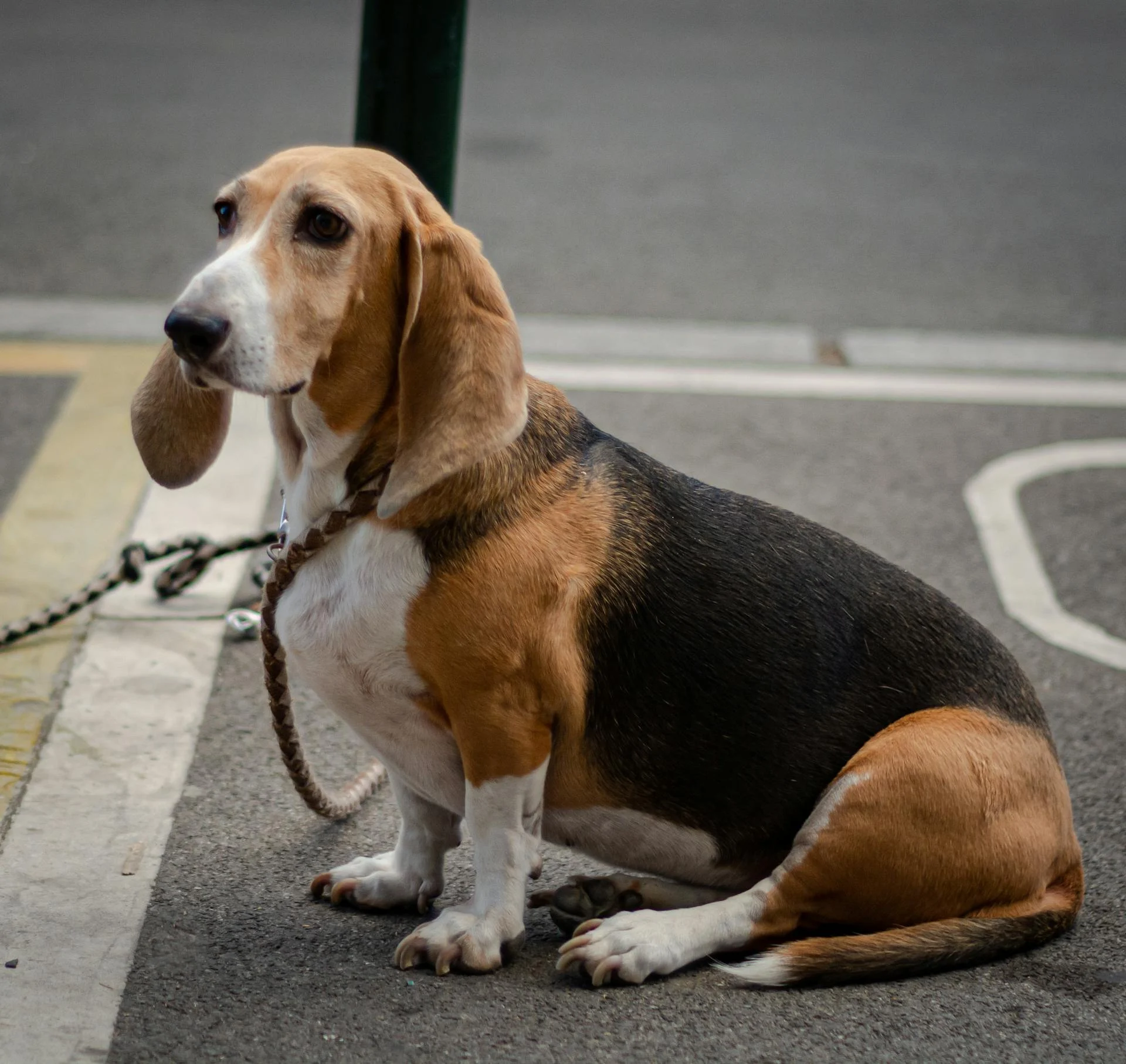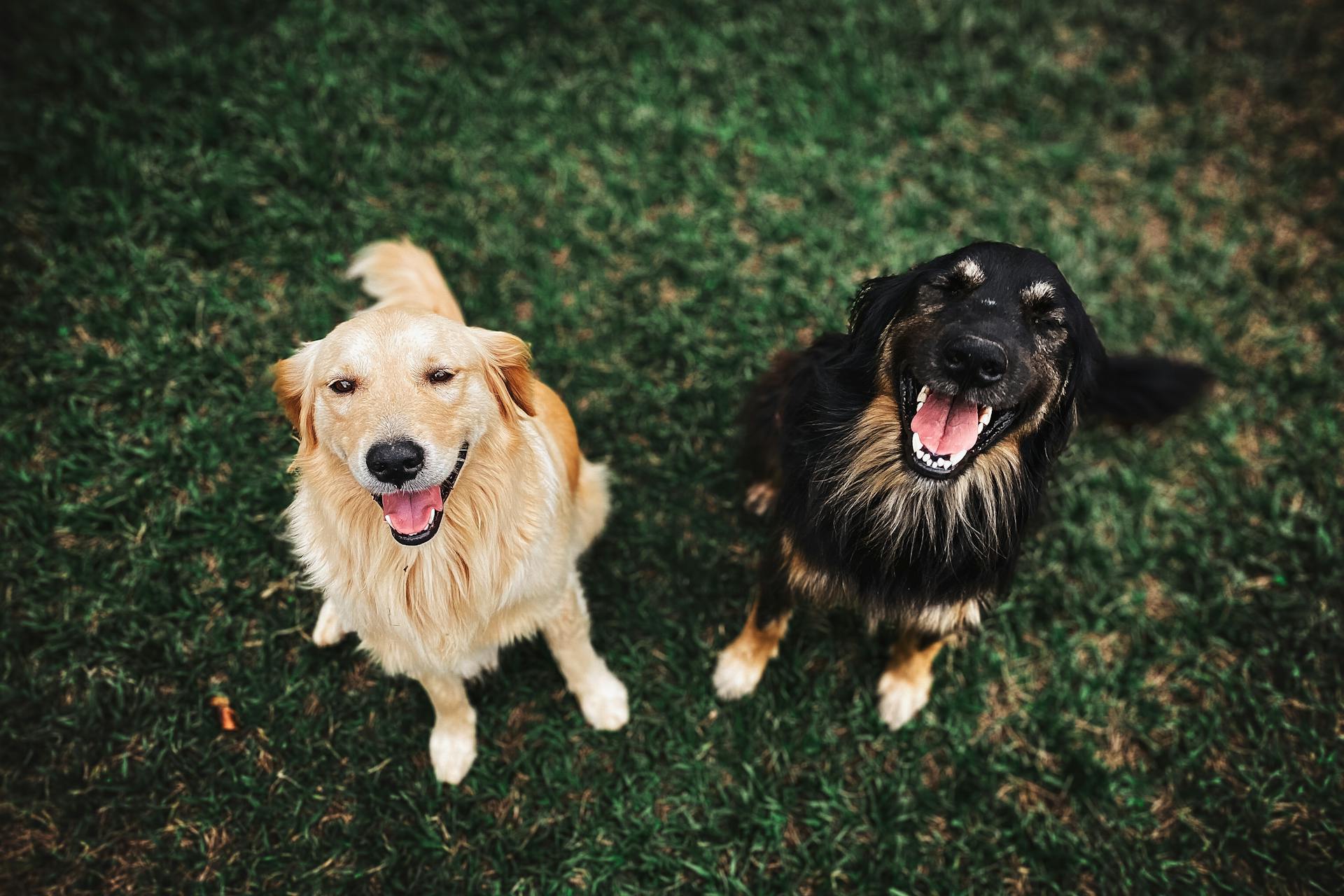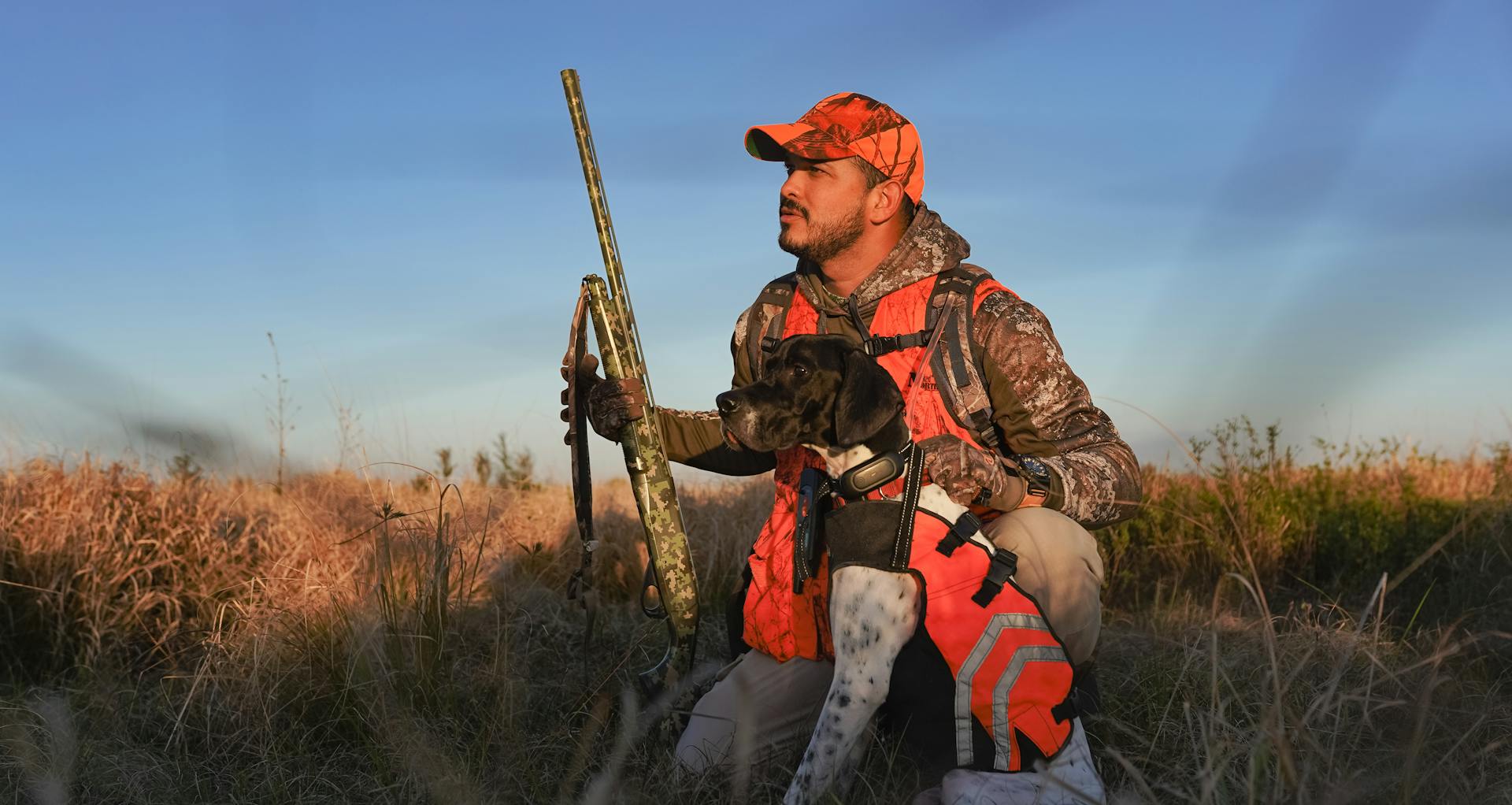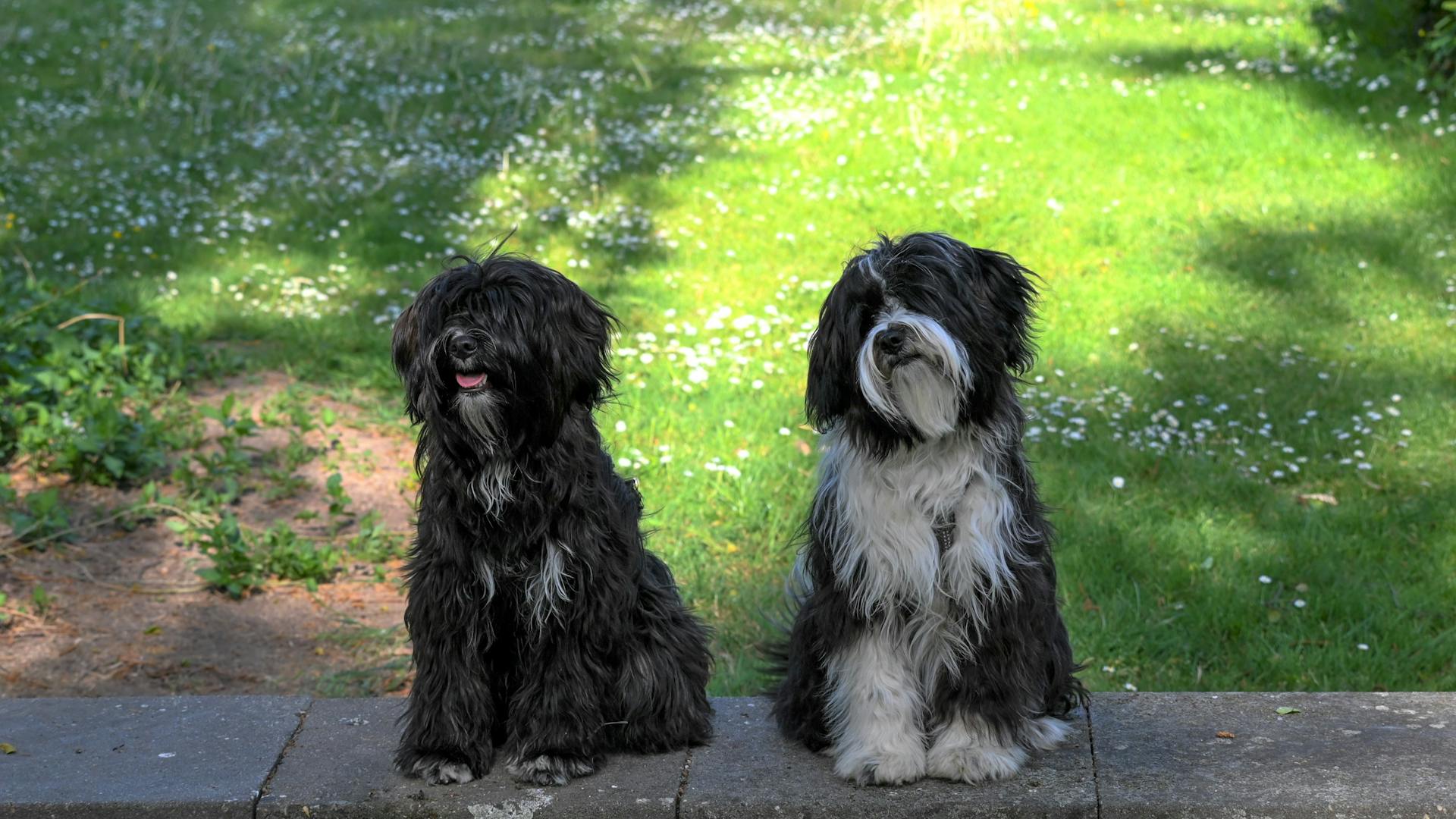
If you're considering adopting a Bluetick Coonhound, you're in for a treat. These dogs are known for their exceptional hunting ability and loving nature.
Bluetick Coonhounds are a relatively rare breed, but they're gaining popularity as more people discover their unique characteristics. They originated in the southern United States and were bred to hunt small game.
A Bluetick Coonhound's average weight is around 45-80 pounds, making them a medium to large-sized breed. Their short, smooth coat requires minimal grooming, which is a bonus for busy owners.
If you're new to dog ownership, a Bluetick Coonhound can be a great choice. They're relatively low-maintenance and can thrive in a variety of living situations.
Temperament and Care
Bluetick Coonhounds are known for their friendly and adventurous nature, making them a great companion for many families. They're independent and strong-willed, but not overly obedient, so be prepared for some mischief.
Their easy-going nature makes them a friend to all, and they enjoy the company of strangers, other dogs, and even other animals if raised with them. They can be quite the escape artists, so make sure to keep a close eye on them.
Bluetick Coonhounds require lots of activity and proper training and socialization to be happy and healthy dogs. Their desire to follow a scent also must be managed, which can be a challenge for some owners.
Temperament
The Bluetick is a laid-back companion that enjoys the company of strangers, other dogs, and even other animals if raised with them. They are notorious counter surfers and escape artists, so be prepared for some mischief.
Friendly and independent, Blueticks are strong-willed and not overly obedient. They like to follow their nose to food or quarry, and will pretend to be deaf to pleas to stop.
Their easy-going nature makes them a great friend to all, and they love to bay loudly when excited. This loud barking can be a challenge in apartments or homes with close neighbors.
Blueticks are adaptable when it comes to living quarters, but they do require plenty of daily exercise. With regular exercise, they can thrive in a variety of environments.
Their "big bawl mouth" is a distinctive feature of the Bluetick breed, characterized by a long, drawn-out bark. This can be a challenge for city dwellers or those with noise restrictions.
Explore further: When to Mate Female Dog
Care
Bluetick coonhounds require lots of activity, along with proper training and socialization, to be happy and healthy dogs. They have a strong desire to follow a scent, which must be managed.
Regular brushing is a must for Bluetick coonhounds, especially with a hound mitt or rubber curry brush, to keep their coat clean and shiny.
Weekly brushing will remove dead hair, preventing it from landing on your floor, furniture, or clothing.
Bathe your Coonhound as needed, but be aware that it won't completely eliminate their natural "houndy" odor.
Trim the nails every few weeks to keep them from getting too long.
Keep those droopy ears clean and dry to prevent bacterial and yeast infections. Brushing the teeth is also essential for good overall health and fresh breath.
The short, shiny coat of a Bluetick coonhound has a moderate shedding rate, requiring routine basic grooming to keep them looking their best.
Plan on a bath roughly every month, depending on how dirty your dog has gotten.
Check your dog's ears at least weekly for any dirt, debris, redness, swelling, or other abnormalities.
A different take: Boston Terrier with Uncropped Ears
Diet and Nutrition
Always have fresh water accessible to your dog.
Maintaining your dog at a healthy weight is crucial, as obesity can increase the risk of other diseases.
Feeding two measured meals per day can help prevent overeating.
If your dog tends to eat quickly, feeding smaller meals more frequently or using a food puzzle can help prevent bloat.
Health and Wellness
Bluetick Coonhounds are generally a healthy breed, but like all dogs, they can be prone to certain health issues. They have a relatively long life span, ranging from 11 to 13 years.
Ear infections are a common problem in Bluetick Coonhounds, caused by bacteria and fungi that can thrive in the warm, moist environment of their floppy ears. Regular ear cleaning and checking can help prevent these infections.
Hip dysplasia is another health issue that can affect Bluetick Coonhounds, particularly those with a large build. This orthopedic problem can cause pain, limping, and difficulty jumping.
A fresh viewpoint: Catahoula Leopard Dog Health Issues
Bloat, also known as gastric dilation and volvulus (GDV), is a life-threatening emergency that can occur when the stomach twists and fills with fluid, gas, or food. This condition requires immediate veterinary attention.
To ensure you're getting a healthy puppy, choose a reputable breeder who can provide written documentation of the parents' hip radiographs (x-rays) and clearance from the Orthopedic Foundation for Animals.
Exercise and Training
Exercise and Training are crucial for Bluetick Coonhounds. They require at least one to two hours of daily physical activity, including brisk walks, jogs, hikes, and play.
These dogs are bred for high energy and endurance, so they need to burn off that energy regularly. You can also get your Bluetick Coonhound involved in dog sports like tracking and agility to challenge them mentally and physically.
Their natural instinct as scent hounds means they'll enjoy exploring natural places like the woods, but always keep them on leash or in a secure fenced area to prevent them from following a scent and getting lost. They're also good escape artists, so monitoring them is essential.
Training should start early, ideally when your Bluetick Coonhound is still a puppy. They respond fairly well to training, but can be stubborn at times, so consistency is key. Use positive training methods and enroll in an obedience class to help strengthen your bond with your dog.
A fresh viewpoint: Dog That Hunts by Scent
Exercise

Exercise is a must for bluetick coonhounds, bred to have high energy and endurance.
Aim to spend at least one to two hours per day on brisk walks, jogs, hikes, and play to burn that energy.
Bluetick coonhounds will enjoy spending time in natural places, such as in the woods, where they can be active and use their nose to catch and track a variety of scents.
Keep your dog on leash or in a secure fenced area when exercising to prevent them from following a scent and getting lost.
Bluetick coonhounds can be good escape artists, so it's best to monitor them even if they're in a fenced area.
Training
Training is a fun and rewarding experience for both you and your dog, but it requires consistency and patience. Training should start early, ideally when your dog is still a puppy.
Use positive training methods to help your dog learn new tricks and behaviors. Consistency is key, so be sure to use the same training cues every time.

Enrolling in an obedience class can be a great way to socialize your dog and help them learn good manners. These classes can also help you build a stronger bond with your dog.
Socialization is just as important as training, and it's best to start early. Expose your dog to different people, other dogs, and various locations to help them feel more comfortable and confident.
Blueticks that don't get enough attention might develop problematic behaviors, so be sure to spend quality time with your dog. They're best suited for households where someone is home most of the day.
You might like: When Is Best to Breed a Dog
Pros and Cons
Bluetick coonhounds can make wonderful pets, but it's essential to consider both the pros and cons before making a decision.
One of the best things about bluetick coonhounds is that they are sweet and loyal. They will quickly become a beloved member of your family.
However, they can be very vocal, so if you live in an apartment or have noise restrictions, this might not be the best breed for you.
On the other hand, bluetick coonhounds are relatively low maintenance when it comes to grooming, which is a big plus for many pet owners.
Their exercise needs are another story, though - they require lots of physical activity to stay happy and healthy.
Here's a quick rundown of the pros and cons:
- Sweet and loyal
- Low grooming maintenance
- Typically gets along well with other dogs
- Can be very vocal
- Can be stubborn and challenging to train
- Needs lots of exercise
Pros
Bluetick Coonhounds are a wonderful breed, and here are some of their best qualities.
They're sweet and loyal companions, always eager to please and show affection.
Their low grooming maintenance is a big plus for busy owners, as they don't require frequent baths or haircuts.
Bluetick Coonhounds typically get along well with other dogs, making them a great addition to families with multiple pets.
Their friendly nature makes them a joy to be around, always happy to play or cuddle.
Cons
If you're considering bringing a Bluetick Coonhound into your family, it's essential to know their potential drawbacks. They can be very vocal, which might not be suitable for everyone, especially those who live in apartments.
Bluetick Coonhounds are known to be stubborn and challenging to train. This can be frustrating for inexperienced dog owners.
They require a lot of exercise, which means you'll need to be prepared to spend time and energy on physical activities with your dog.
Here are some key cons to consider:
- Can be very vocal
- Can be stubborn and challenging to train
- Needs lots of exercise
Adoption and Ownership
Adopting a Bluetick Coonhound can be a wonderful experience, but it's essential to know what to expect. If you're looking for a breeder puppy, be prepared to pay around $1,000 on average, though this can vary depending on bloodline and other factors.
You can also consider adopting from a local animal shelter or breed rescue organization. Sites like Petfinder.com and Adopt-a-Pet.com can help you find a Bluetick in your area, and you can be specific in your requests or general in your search. AnimalShelter.org can also help you find animal rescue groups in your area.
If you're looking to adopt an adult Bluetick, you can reach out to local experts like vets, dog walkers, and groomers to see if they know of any Blueticks in need of a home. Breed rescue groups, like the Dixie Coonhound Rescue, can also help you find a dog that may be the perfect companion for your family.
Explore further: Why Adopting a Pet Is Better?
Here are some key questions to ask shelter or rescue group staff or volunteers before bringing home a pup:
- How is he around other animals?
- How does he respond to shelter workers, visitors, and children?
- Is he housetrained?
- Has he ever bitten or hurt anyone that they know of?
- Are there any known health issues?
Remember to get a good contract with the seller, shelter, or rescue group that spells out responsibilities on both sides.
Adopting or Buying a Pet
If you're looking to bring a Bluetick Coonhound into your life, there are several options to consider. You can expect to pay around $1,000 on average for a breeder puppy, although this can vary widely depending on bloodline and other factors.
You can check local animal shelters and breed-specific rescue groups for a Bluetick Coonhound in need of a home. Some great resources include the National Bluetick Coonhound Association, Bluetick Breeders of America, and Bluetick Coonhound Rescue.
If you're set on adopting a dog, you can start by searching online platforms like Petfinder.com and Adopt-a-Pet.com, which allow you to be specific in your requests or general in your search. You can also check AnimalShelter.org to find animal rescue groups in your area.
Networking with local pet pros, such as vets, dog walkers, and groomers, can also be a great way to find a Bluetick. Many people who love Blueticks will ask their trusted network for recommendations when they need to rehome a dog.
Breed rescue groups, like the Dixie Coonhound Rescue, can also be a valuable resource. They often have a good understanding of the dogs' health and temperament, and may offer fostering opportunities so you can try out the experience before committing to adoption.
Before bringing home a Bluetick, it's essential to ask the right questions. You should discuss the dog's behavior around other animals, children, and strangers, as well as any known health issues.
Here are some key questions to ask shelter or rescue group staff or volunteers:
- How is the dog around other animals?
- How does the dog respond to shelter workers, visitors, and children?
- Is the dog housetrained?
- Has the dog ever bitten or hurt anyone?
- Are there any known health issues?
Remember to have a good contract with the seller, shelter, or rescue group that spells out responsibilities on both sides.
Choosing a Breeder
Research is key when selecting a reputable breeder, so spend some time reading reviews and asking for referrals.
A good breeder will have a clear understanding of the breed's needs and temperament, which is why it's essential to find one who has experience with the specific breed you're interested in.
They should also be transparent about the health and genetic history of the parents, which can help you make an informed decision about your new pet.
A reputable breeder will prioritize the health and well-being of their animals, so look for one who is willing to let you visit their facility and meet the parents of the puppy.
This will give you a chance to see the conditions they're kept in and get a sense of the breeder's values and priorities.
A good breeder will also have a contract that includes a spay/neuter requirement, which can help prevent pet overpopulation.
They may also offer a health guarantee, which can provide peace of mind as you welcome your new pet into your home.
Take a look at this: Boston Terrier New England
Information and Pictures
In the United States alone, over 400,000 children are in foster care, waiting for a permanent home.
The process of adoption can be complex and time-consuming, with some adoptions taking up to two years or more to complete.
A family's decision to adopt is often driven by a desire to provide a loving home to a child in need.
The average cost of domestic adoption is around $20,000 to $40,000, not including the cost of agency fees and other expenses.
Many adoptive families choose to adopt children from foster care, where they can provide a stable and loving home to a child who may have experienced trauma.
Research has shown that children adopted from foster care are just as capable of forming secure attachments as those adopted from other sources.
Adopted children can benefit from open adoption, where they have ongoing contact with their birth family.
In the United States, 65% of adopted children are adopted by their married parents, while 22% are adopted by single mothers.
Discover more: Bavarian Mountain Hound Cost
The majority of children adopted from foster care are between the ages of 5 and 9, with 45% being between 5 and 7 years old.
The adoption process varies by state, with some states offering expedited adoption procedures for families who have a strong connection to the child or who are adopting from foster care.
Frequently Asked Questions
Are Bluetick Coonhounds good house dogs?
Yes, Bluetick Coonhounds can make great house dogs, but they do require regular exercise and a securely fenced yard to prevent wandering.
Do Bluetick Coonhounds like to cuddle?
Yes, Bluetick Coonhounds are known to be affectionate and love cuddling with their human family. They enjoy physical closeness and often seek out snuggles and attention.
Do Bluetick hounds bark a lot?
Bluetick coonhounds are known for their loud, baying barks, which can be a consideration for families with noise restrictions. Their barking style is distinct from other breeds and may require some adjustment for owners.
Featured Images: pexels.com


